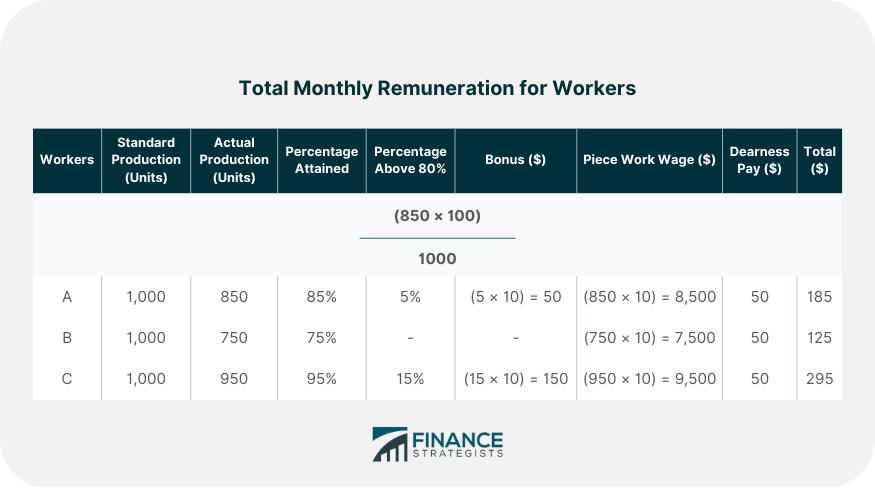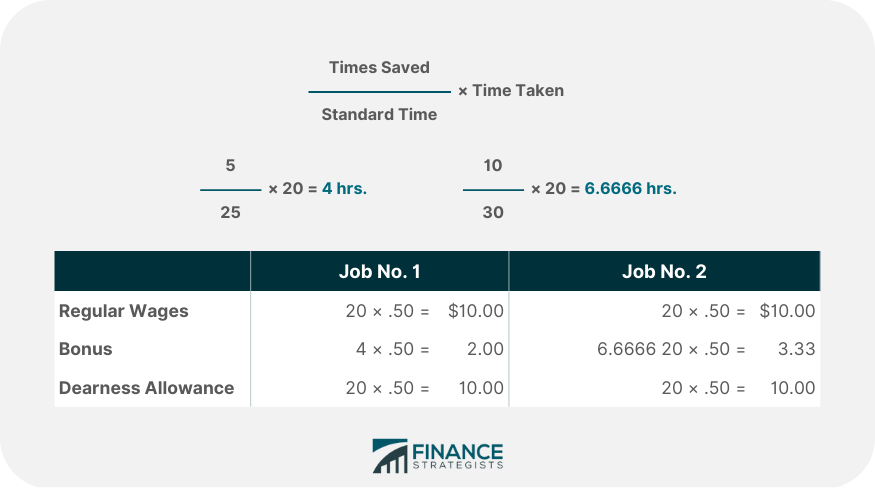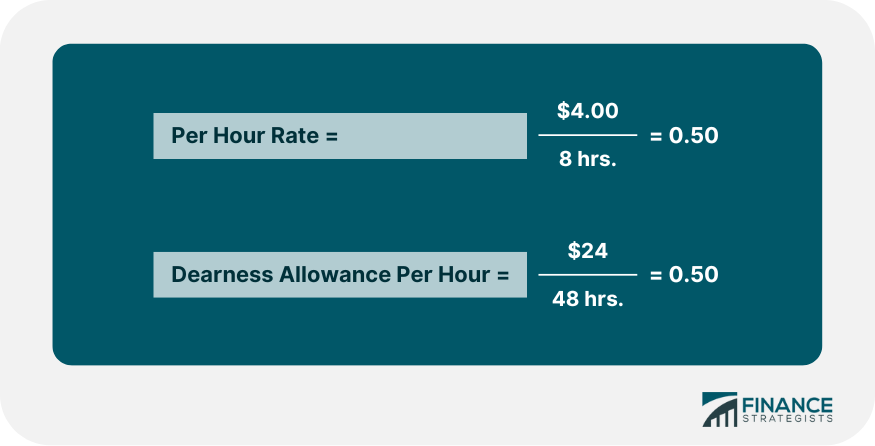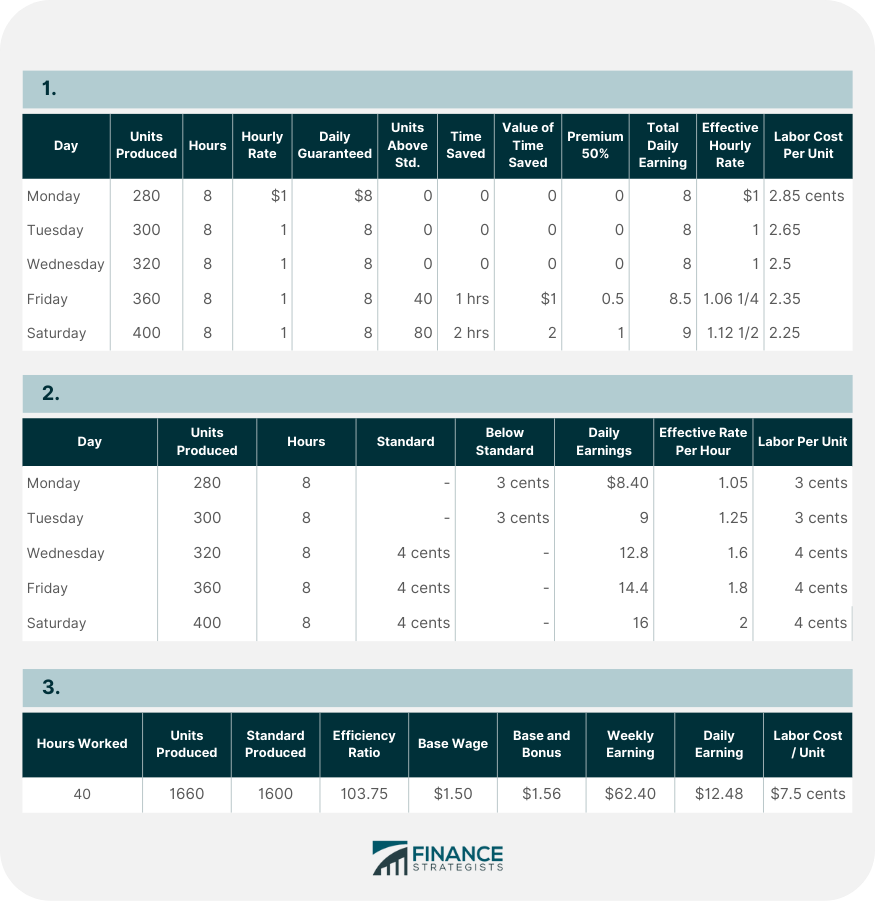Consider the following information concerning the monthly remuneration of three workers: Required: Calculate the total monthly remuneration for three workers: A, B ,and C. Production sections of a factory working on a job order system pay their workers under the Rowan Premium Bonus Scheme. Workers are also entitled to a dearness allowance of $25 per week of 48 hours. A worker's basic wage is $4 per day (8 hours), and the timesheet for a week is summarized below. Idle time (waiting) 8 hours. Required: Calculate the gross wages that a worker earns for the week. An operator engaged in machining components receives an ordinary day rate of $160 per day for an 8-hour day. The standard output for machining the components has been fixed at $0.80 per hour (time fixed for premium bonus). On a certain day, the worker's output on the machine is 800. Required: Find the labor cost per 100 pieces and the wages earned under the following conditions: 1. Bonus of $19 is paid per 100 extra output Standard time for 640 pieces = 8 hrs. Standard time for 1 piece = 8 / 640 hrs. Standard time for 800 pieces = (8 x 800) / 640 = 10 hrs. Time taken = 8 hrs. Time saved or bonus hours = 10 - 8 = 2 hrs. 50% of time saved = 2 x (50 / 100) = 1 hour Regular wages = $160.00 Bonus = (1 x 160) / 8 = $20.00 Total earnings = 160 + 20 = $180.00 Per 100 piece earnings = (180 / 800) x 100 = $22.50 The time and motion study department of Moonlight Corporation has informed you that standard production on a specific item is 40 units per hour. During the last week of December, a worker's record shows the following for each 8-hour day: Required: Prepare a schedule showing the worker's daily earnings, the effective hourly rate, and the labor cost per unit under the following conditions:Question 1
Solution

Question 2
Job No.
Time Allowed
Time Taken
1
25 hours
20 hours
2
30 hours
20 hours
Solution
Job No. 1
Job No. 2
Time Allowed
25 hrs.
30 hrs.
Time Taken
20 hrs.
20 hrs.
Time Saved
05 hrs.
10 hrs.
Bonus Hours (Rowan Plan)

Gross Earnings
Job No. 1
$22.00
Job No. 2
$23.33
Idle time wages (8 x .50)
$4.00
Dearness allowance for idle time (8 x 0.50)
$4.00
Total wages
$53.33
Calculation

Question 3
Solution
Standard output per hour
= 80 pieces
Standard output per day or for 8 hours
= 80 x 8
= 640 pieces
Actual output in 8 hours or in a day
= 800 pieces
Extra output
= 800 - 640
= 160 pieces
Bonus
For 100 extra output, bonus is
= $19.00
For 1 extra output, bonus is
= $19.100
For 160 extra output, bonus is
= (19 / 100) x 160
= $30.40
Regular wages for 8 hours
= $160.00
+ Bonus
= $30.40
Total wages
= $190.40
Per 100 Piece Wages
For 800 pieces wages
= $190.40
For 1 piece wages
= $190.40/800
For 100 pieces wages
= (190.40 / 800) x 100 = $23.80
2. Straight Piece of Rate
Per piece wages
= 160 / 640
= $0.25
For 800 pieces wages
= 800 x 0.25
= $200
Per 100 pieces wages
= (200 / 800) x 100
= $25
3. Halsey Premium Bonus SystemFormula for Halsey Premium Scheme
Question 4
Monday
280 units
Tuesday
300 units
Wednesday
320 units
Thursday
Factory closed
Friday
360 units
Saturday
400 units
Solution

Labor Costing: Practical Questions With Answers FAQs
Lost or misplaced records are the most common problem in labor costing. Many business owners and managers often fail to keep accurate and complete records that may result in inaccurate information for processing payrolls which could lead to severe consequences such as penalties or lawsuits.
Labour costing is a method of charging the manufacturing cost to the jobs manufactured.
Total labor cost for a period divided by units produced during the same time period. Labor rate x units produced = labor cost
The four types of labor costs are variable labor, fixed labor, direct labor, and indirect labor.
Labor costing is more accurate than job order costing because it charges costs directly to the jobs manufactured.
True Tamplin is a published author, public speaker, CEO of UpDigital, and founder of Finance Strategists.
True is a Certified Educator in Personal Finance (CEPF®), author of The Handy Financial Ratios Guide, a member of the Society for Advancing Business Editing and Writing, contributes to his financial education site, Finance Strategists, and has spoken to various financial communities such as the CFA Institute, as well as university students like his Alma mater, Biola University, where he received a bachelor of science in business and data analytics.
To learn more about True, visit his personal website or view his author profiles on Amazon, Nasdaq and Forbes.











